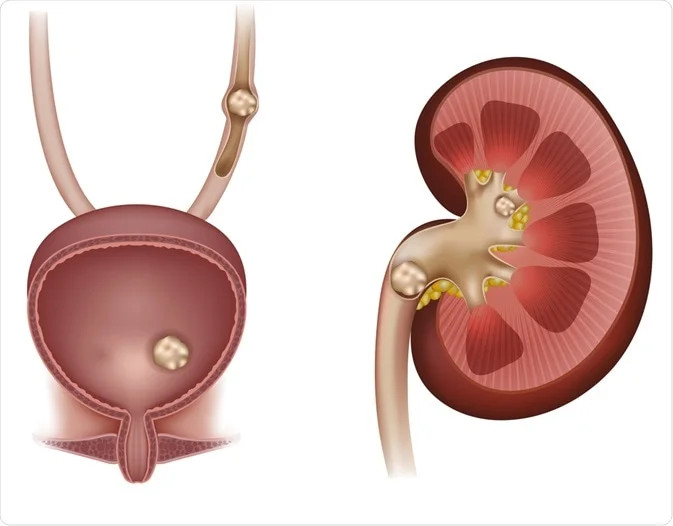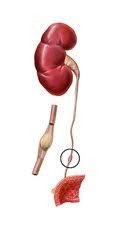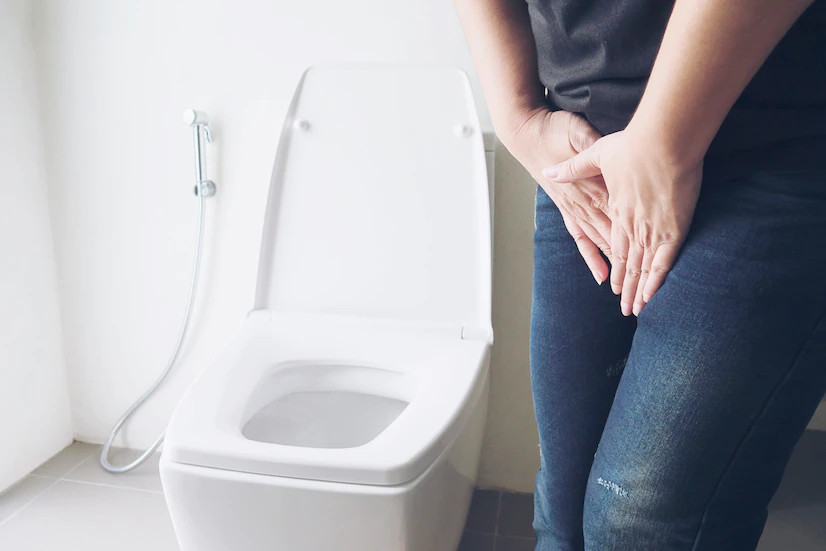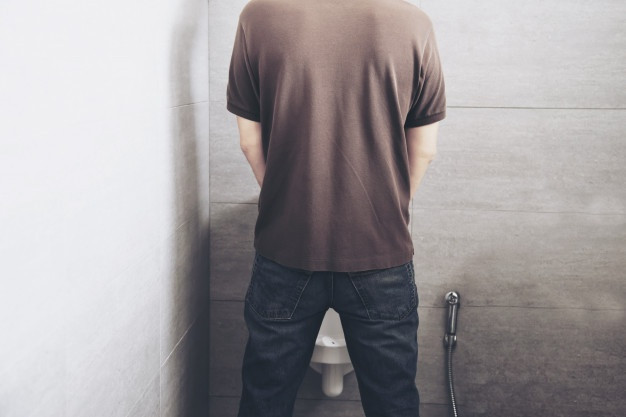Definisi
Urolitiasis atau batu saluran kemih adalah penyakit yang ditandai dengan pembentukan batu di saluran kemih. Batu saluran kemih terbentuk dari mineral yang mengalami kristalisasi di dalam urin.
Batu ini dapat berada di bagian mana saja di saluran kemih, seperti ureter (saluran yang tersambung dari ginjal ke kandung kemih), kandung kemih, dan uretra (saluran tempat urin keluar). Lokasi paling sering adalah di ginjal (nefrolitiasis) dan kandung kemih.
Mineral yang sering ditemukan menyebabkan pembentukan batu ini adalah:
- Kalsium oksalat
- Fosfat
- Struvite (amonium magnesium fosfat)
- Asam urat
80% batu biasanya terdiri dari kalsium oksalat atau fosfat. Urolitiasis awalnya terbentuk di ginjal namun dapat keluar dan berdiam di sepanjang saluran kemih, mulai dari saluran ureter, kandung kemih, sampai uretra (jarang terjadi).
Batu yang menyumbat saluran kemih ini dapat menimbulkan gejala seperti nyeri pada perut atau pinggang. Batu yang berukuran kecil dapat keluar dari saluran kemih dengan sendirinya. Namun, batu yang sudah membesar memerlukan tindakan medis tertentu untuk mengeluarkannya. Batu yang dibiarkan di saluran kemih akan menimbulkan infeksi dan komplikasi lain.
Laki-laki lebih sering mengalami urolitiasis dibandingkan perempuan, dengan rasio 3:1. Usia puncak terjadinya batu pada laki-laki adalah 40-60 tahun, serta pada perempuan pada usia 20 tahun akhir.
Penyebab
Urolitiasis terbentuk ketika urin mengandung lebih banyak zat pembentuk batu seperti kalsium, oksalat, dan asam urat, dibandingkan dengan cairan di urin untuk melarutkannya. Pada saat yang sama, urin juga dapat mengalami kekurangan zat yang mencegah pembentukan batu. Sehingga urin akan terkonsentrasi dan komponen di dalamnya membentuk kristal dan menjadi batu.
Komponen batu di saluran kemih paling sering adalah batu kalsium. Selain kalsium, komponen lain yang dapat membentuk batu adalah asam urat, sistein, atau struvite. Kondisi ini juga terjadi karena kandungan komponen tesebut sangat tinggi di dalam urin.
1. Batu Kalsium
Umumnya batu tersusun dari batu kalsium, biasanya dalam bentuk kalsium oksalat. Okslata merupakan zat yang diproduksi setiap hari oleh hati serta didapatkan dari makanan. Beberapa buah dan sayuran seperti kacang dan cokelat memiliki kandungan oksalat yang tinggi. Faktor diet, konsumsi vitamin D dosis tinggi, dan penyakit metabolik berat dapat meningkatkan kandungan kalsium atau oksalat dalam urin.
Batu kalsium juga dapat muncul dalam bentuk kalsium fosfat. Tipe batu ini lebih sering ditemukan pada orang-orang dengan penyakit metabolik. Penderita batu saluran kemih yang terdiri dari kalsium juga dikaitkan dengan obat-obatan tertentu untuk migrain atau kejang, seperti topiramate.
2. Batu Asam Urat
Batu asam urat dapat terbentuk pada:
- Oorang yang kehilangan banyak cairan akibat diare berkepanjangan atau gangguan penyerapan nutrisi
- Orang yang mengonsumsi makanan tinggi protein
- Penderita diabetes atau sindrom metabolik
- Gout atau radang sendi akibat penumpukan kristal asam urat
- Orang dengan faktor genetik
3. Lain-Lain
Batu struvite terbentuk sebagai respon terhadap infeksi saluran kemih. Sementara itu, batu sistein biasanya terbentuk pada orang dengan penyakit keturunan (sistinuria) yang menyebabkan ginjal mengeluarkan asam amino tertentu di urin.
Selain itu, batu saluran kemih juga dapat disebabkan oleh :
-
Infeksi
Adanya infeksi akan mengganggu kemampuan kandung kemih untuk menahan, menyimpan, dan mengeluarkan urin sehingga batu kandung kemih akan lebih mudah terbentuk.
-
Pembesaran kelenjar prostat.
Kondisi yang terjadi pada laki-laki ini dapat menyebabkan pembentukan batu kandung kemih. Pembesaran prostat akan mengganggu aliran urin dan membuat kandung kemih tidak dapat kosong sempurna.
-
Kerusakan saraf.
Saraf yang berada di seluruh saluran kemih. Pada kondisi normal saraf akan mengirimkan pesan kepada otak untuk mengosongkan kandung kemih ketika urin sudah penuh. Kerusakan pada saraf ini karena stroke, cedera tulang belakang, atau masalah kesehatan lain juga akan membuat kandung kemih tidak kosong sempurna. Kondisi ini disebut neurogenic bladder.
-
Peradangan
Peradangan kandung kemih atau saluran kemih lainnya dapat disebabkan infeksi saluran kemih atau terapi radiasi di area pelvis.
-
Penggunaan alat medis.
Contoh paling sering adalah kateter atau selang urin yang dimasukkan ke uretra dan kandung kemih untuk membantu mengeluarkan urin. Kristal mineral biasanya terbentuk pada permukaan alat medis ini.
-
Kandungan di dalam urin berubah.
Urin biasanya mengandung zat yang mencegah pembentukan batu. Zat tersebut bernama sistrat.
Faktor Risiko
Faktor risiko dari batu saluran kemih cukup beragam. Pada batu kandung kemih risiko meningkat pada laki-laki usia tua, biasanya di atas usia 50 tahun.
Tipe batu yang berbeda bisa terbentuk karena beragam faktor risiko, seperti diet, riwayat kesehatan Anda dan keluarga terkait batu, faktor lingkungan, serta pengobatan. Faktor yang dapat meningkatkan risiko terbentuknya batu pada urolitiasis meliputi:
1. Riwayat keluarga dan personal
Jika terdapat anggota keluarga Anda yang pernah mengalami batu saluran kemih, maka Anda lebih mungkin untuk mengalami urolitiasis juga. Jika Anda pernah mengalami batu saluran kemih, maka Anda lebih berisiko untuk mengalami batu lagi di kemudian hari.
2. Dehidrasi
Kurangnya asupan cairan sehari-hari akan meningkatkan risiko terbentuknya batu saluran kemih. Orang yang tinggal di iklim hangat dan kering serta banyak berkeringat lebih berisiko kekurangan cairan.
3. Diet tertentu
Pola makan yang tinggi protein, garam, dan gula meningkatkan risiko terbentuknya beberapa tipe batu, terutama diet tinggi garam.
4. Obesitas
Kelebihan berat badan dihubungkan dengan peningkatan risiko batu saluran kemih.
5. Penyakit dan operasi pencernaan
Hal ini akan mempengaruhi penyerapan kalsium dan air sehingga meningkatkan jumlah zat pembentuk batu pada urin.
6. Kondisi medis dan obat tertentu
Suplemen dan obat tertentu, seperti vitamin C, suplemen makan, obat pencahar (jika berlebihan), antasida yang mengandung kalsium, dan obat untuk terapi migrain dan depresi dapat meningkatkan risiko seseorang mengalami batu saluran kemih. Kondisi medis seperti infeksi saluran kemih berulang juga bisa menjadi faktor risiko batu saluran kemih.
Gejala
Gejala pada urolitiasis bervariasi, mulai dari tidak menimbulkan keluhan sama sekali sampai sakit berat. Batu ginjal yang tersangkut di ureter dapat menghambat aliran urin, membuat urin kembali naik ke atas ginjal dan menyebabkan pembengkakan ginjal. Batu juga bisa membuat ureter berkontraksi yang dapat terasa sangat nyeri. Jika hal ini sudah terjadi maka Anda dapat mengalami gejala seperti:
- Nyeri tajam yang berat pada sisi bawah tubuh, yang bisa menjalar ke perut bawah dan lipat paha.
- Nyeri hilang-timbul dengan intensitas yang bervariasi.
- Nyeri atau sensasi terbakar saat buang air kecil.
Gejala dan tanda lainnya yang juga mungkin menyertai keluhan nyeri meliputi:
- Urine bisa keruh, berbau menyengat, atau berwarna pink/merah/kecokelatan
- Ada rasa ingin buang air kecil terus-menerus dan saat BAK jumlah urin sedikit-sedikit
- Mual dan muntah
- Demam dan menggigil
Diagnosa
Dokter dapat mewawancarai keluhan dan gejala yang dirasakan pasien. Saat pemeriksaan fisik pada tubuh pasien, dokter akan melihat bila terdapat tanda klinis yang mengarah pada diagnosis urolitiasis. Jika dokter mencurigai adanya batu pada saluran kemih, maka dokter akan mengusulkan pemeriksaan penunjang seperti:
1. Pemeriksaan Darah
Pemeriksaan ini akan menunjukkan kelebihan kalsium atau asam urat di darah, serta membantu memonitor kesehatan ginjal dan juga mendeteksi adanya kondisi medis lainnya.
2. Pemeriksaan Urine
Pada pemeriksaan urin, dapat dilihat bila ada sel darah merah, sel darah putih, atau adanya mineral pembentuk batu yang berlebihan pada urin.
3. Pemeriksaan Pencitraan
Pemeriksaan ini akan dilakukan untuk melihat bila ada batu ginjal pada saluran kemih. Dokter bisa memilih untuk dilakukan USG, rontgen, CT scan atau MRI pada area perut, pinggang, atau organ saluran kemih.
4. Analisa Batu
Terdapat beberapa tipe batu ginjal yang berbeda berdasarkan penyebabnya. Pemeriksaan ini dapat mencari tahu susunan dari batu dan memberikan petunjuk cara menurunkan risiko pembentukan batu di kemudian hari.
Tata Laksana
Secara umum, terapi urolitiasis bergantung pada tipe batu dan penyebabnya. Batu yang berukuran kecil dengan gejala yang minimal biasanya tidak membutuhkan terapi agresif. Anda mungkin akan disarankan untuk meminum banyak cairan untuk menjaga agar urin tidak pekat dan mencegah pembentukan batu. Untuk mengatasi nyeri, dokter biasanya akan memberikan obat antinyeri. Pada batu yang terinfeksi, dokter juga bisa memberikan antibiotik.
Dokter mungkin juga akan memberikan obat-obatan untuk membantu mengeluarkan batu. Obat ini merupakan golongan penghambat alfa yang bekerja dengan merelaksasi otot ureter, sehingga batu lebih mudah lewat dengan nyeri yang minimal. Pada batu yang berukuran besar dan menyebabkan gejala berat seperti perdarahan, infeksi saluran kemih, atau kerusakan ginjal, maka akan dibutuhkan terapi yang lebih agresif seperti:
- ESWL (extracorporeal shock wave lithotripsy), prosedur yang menggunakan gelombang suara untuk membentuk gelombang kejut yang dapat memecah batu menjadi ukuran yang lebih kecil.
- Nefrolitotomi perkutan, prosedur operasi untuk mengeluarkan batu yang sangat besar di ginjal.
- Ureteroskopi, prosedur dengan menggunakan selang tipis yang dilengkapi lampu dan kamera. Selang ini akan dimasukan ke dalam ureter untuk mengeluarkan batu yang kecil di dalam ureter atau ginjal.
Komplikasi
Urolitiasis bisa menyebabkan komplikasi bila tidak diterapi sejak dini. Komplikasi yang dapat terjadi adalah:
- Gangguan fungsi ginjal sampai gagal ginjal. Kerusakan ginjal permanan terutama bila saluran kemih sudah tersumbat sempurna.
- Hidronefrosis. Disebabkan urin yang naik kembali ke ginjal dan meningkatkan tekanan di ginjal hingga ginjal membengkak dan rusak.
- Infeksi saluran kemih, terjadi karena penumpukan urin yang menyebabkan pertumbuhan bakteri. Infeksi juga dapat menyebar ke aliran darah dan menjadi sepsis.
- Infeksi ginjal atau pyelonefritis.
- Sepsis (masuknya bakteri ke dalam aliran darah)
Pencegahan
Terdapat beberapa obat yang dapat mencegah pembentukan batu tertentu, biasanya diresepkan oleh dokter. Di rumah, Anda bisa melakukan hal-hal berikut untuk menurunkan risiko urolitiasis, yaitu:
- Minum air yang cukup dalam sehari. Minimal 2-3 liter per hari.
- Mengurangi konsumsi makanan tinggi oksalat dan asam urat.
- Diet rendah garam dan protein hewani
- Tetap konsumsi makanan tinggi kalsium, namun hati-hati dalam mengonsumsi suplemen kalsium.
- Hindari menahan buang air kecil (BAK).
- Segera berobat ke dokter bila memiliki risiko seperti pembesaran prostat, infeksi saluran kemih, dan masalah saraf.
Kapan Harus ke Dokter?
Anda perlu untuk mencari pertolongan medis segera jika Anda mengalami gejala seperti:
- Nyeri berat yang sampai menyebabkan Anda tidak dapat duduk diam atau menemukan posisi yang nyaman
- Nyeri yang disertai mual dan muntah
- Nyeri yang disertai demam dan menggigil
- Darah pada urin
- Kesulitan buang air kecil
Mau tahu informasi seputar penyakit lainnya? Cek di sini, ya!
- dr Anita Larasati Priyono
Kidney stones - Diagnosis and treatment - Mayo Clinic. (2022). Retrieved 23 June 2022, from https://www.mayoclinic.org/diseases-conditions/kidney-stones/diagnosis-treatment/drc-20355759
Thakore, P., & Liang, T. (2022). Urolithiasis. Retrieved 23 June 2022, from https://www.ncbi.nlm.nih.gov/books/NBK559101/
Knott, D. (2022). Urolithiasis (Urinary Tract Stones and Bladder Stones). Retrieved 23 June 2022, from https://patient.info/doctor/urinary-tract-stones-urolithiasis











